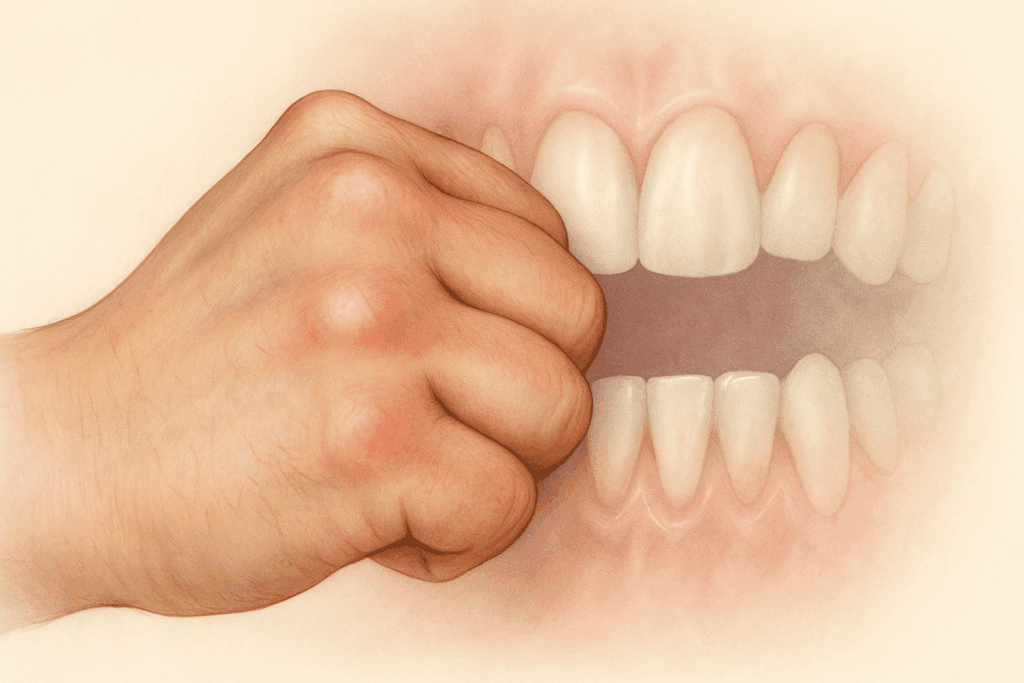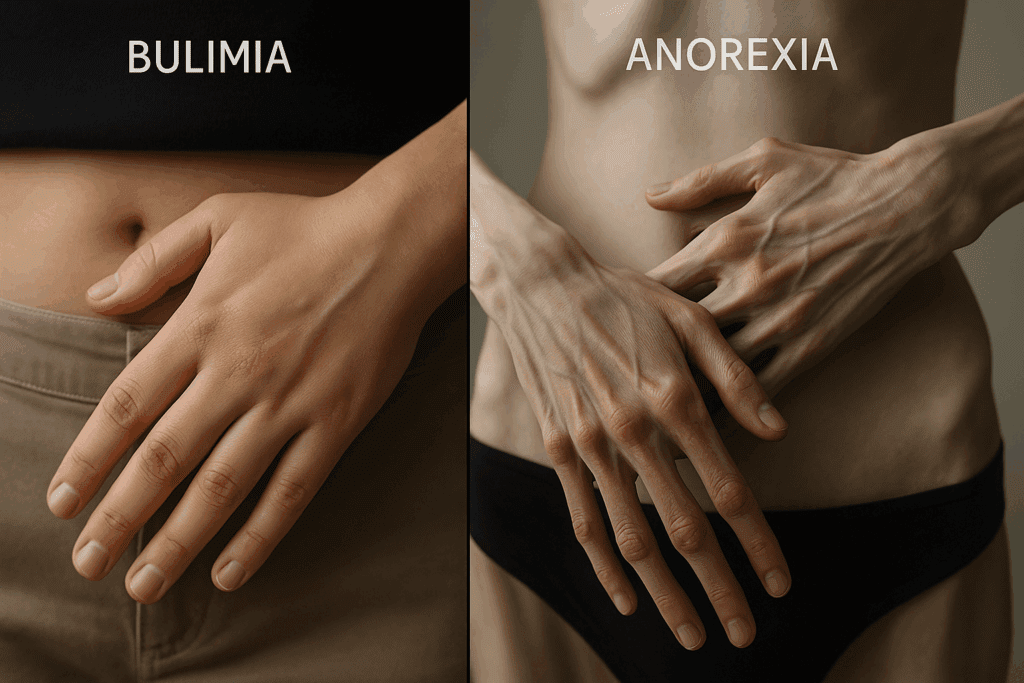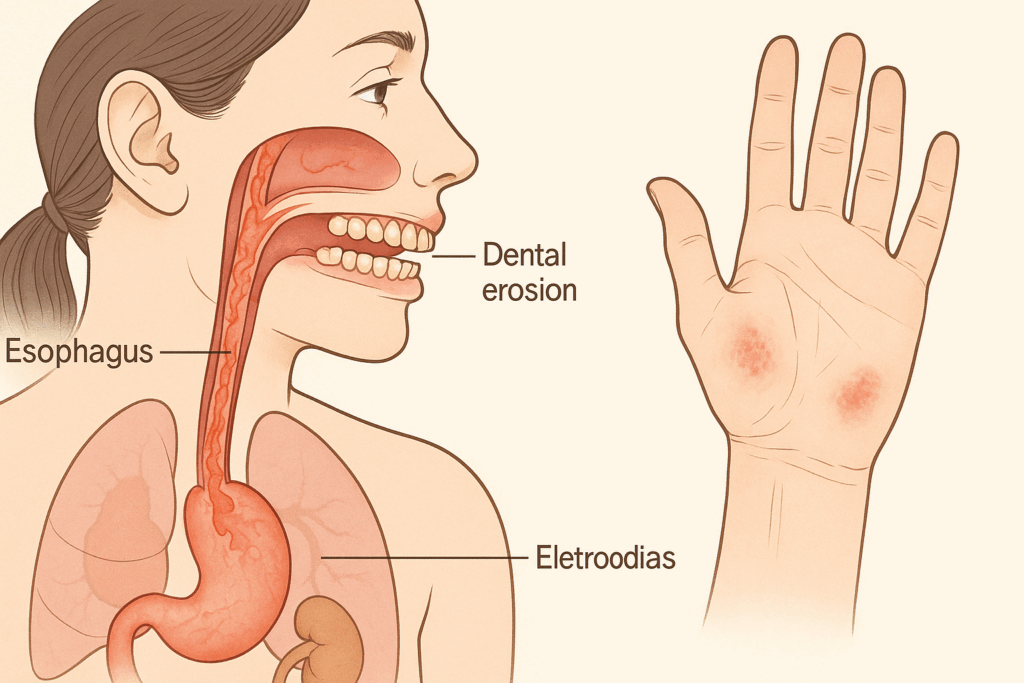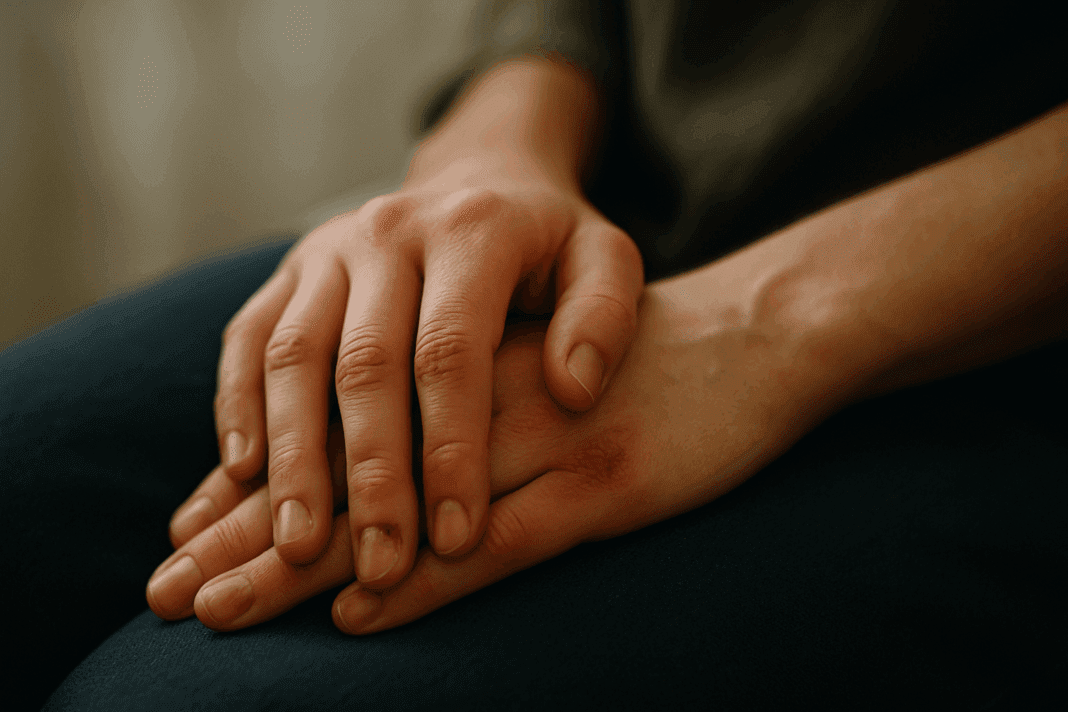Eating disorders can manifest in various ways, both internally and externally. While much of the focus in clinical and mainstream discussions centers around psychological symptoms and weight fluctuations, physical markers are also significant indicators of underlying disordered eating behaviors. One such physical sign is known as Russell’s sign, which refers to calluses, scarring, or abrasions on the knuckles caused by repeated self-induced vomiting. These telltale signs on the hands and knuckles can offer valuable clues to health professionals, loved ones, and individuals themselves about the presence of an eating disorder like bulimia nervosa or, in some cases, anorexia nervosa. Understanding what bulimia hands, bulimia knuckles, and anorexia hands look like and what they signify is a critical step in supporting early intervention and effective treatment.
You may also like: How to Stop Emotional Eating and Regain Control: Mindful Nutrition Strategies That Support a Healthier Lifestyle
The physical consequences of eating disorders often carry deep psychological roots. Recognizing signs like Russell’s sign isn’t merely about identifying surface-level symptoms; it opens a window into a person’s internal struggle with food, body image, and self-worth. Acknowledging these signs in a compassionate and medically informed way is essential for building trust, initiating conversations, and guiding individuals toward healing. By exploring the meaning, causes, and implications of Russell’s sign, and addressing questions like “does Russell’s sign appear with anorexia” or “does anorexia cause calluses on knuckles,” we can shed light on a topic often shrouded in silence and stigma.

What Is Russell’s Sign and Why Does It Matter?
Russell’s sign is named after British psychiatrist Gerald Russell, who was instrumental in identifying and describing bulimia nervosa in the late 1970s. The term specifically refers to lesions, abrasions, or calluses found on the knuckles or backs of the hands, typically resulting from repeated contact with the teeth during self-induced vomiting. This mechanical friction creates visible changes in the skin that may appear as thickened, reddened, or scarred areas. Although not present in every case, Russell’s sign remains a frequently noted physical marker in individuals with bulimia nervosa.
What makes Russell’s sign particularly important is its diagnostic potential. While many eating disorders are hidden or minimized by those suffering, physical signs like bulimia knuckles can alert clinicians or family members to a deeper, potentially life-threatening issue. The hands can become silent witnesses to the suffering that individuals are often reluctant or unable to articulate. Moreover, these signs are not limited to bulimia alone. In some cases, especially those involving purging behavior, Russell’s sign may appear in individuals with anorexia nervosa. This raises an important question: does Russell’s sign appear with anorexia? The answer is yes, particularly in the binge-purge subtype, where individuals engage in similar behaviors as those seen in bulimia.
In clinical settings, the presence of Russell’s sign can support a diagnosis when paired with psychological assessments and a detailed personal history. While not conclusive on its own, it serves as a visual cue that invites further inquiry. Its recognition is essential for timely intervention, making the understanding of bulimia hands and fingers more than a surface-level concern. It becomes a pathway to potentially life-saving conversations.

Understanding the Causes Behind Bulimia Knuckles and Hands
The development of bulimia hands is tied directly to the physical act of purging through vomiting. Individuals with bulimia often use their fingers to induce vomiting, causing repeated trauma to the skin on their knuckles. Over time, this trauma leads to friction burns, calluses, or scarring, especially on the dominant hand. These physical alterations are collectively referred to as bulimia knuckles, and their appearance can range from subtle discoloration to pronounced scabbing and skin thickening.
The friction responsible for these changes typically occurs between the knuckles and the upper incisors. As the knuckles come into contact with the teeth during purging, the repeated scraping action compromises the integrity of the skin. The result is not only painful but visible evidence of harmful behavior. These symptoms can sometimes be confused with dermatological conditions or dismissed as minor injuries, especially if the affected individual conceals the underlying cause. This makes it crucial for healthcare providers and caregivers to understand the link between skin damage and purging behavior.
When addressing the question “does anorexia cause calluses on knuckles,” it’s important to differentiate between anorexia nervosa and its binge-purge subtype. Classic anorexia involves caloric restriction without purging, but in the binge-purge variant, behaviors mirror those of bulimia nervosa. In such cases, yes, anorexia can lead to the same hand and knuckle symptoms. Thus, whether we are examining bulimia fingers or anorexia hands, the root behavior—self-induced vomiting—is the primary factor leading to these physical signs.

Differentiating Between Bulimia and Anorexia in Physical Manifestations
Understanding the differences in physical symptoms between bulimia and anorexia can offer deeper insight into diagnosis and treatment. While Russell’s sign is more frequently associated with bulimia, it is not exclusive to it. In anorexia nervosa, particularly the binge-purge subtype, similar behaviors like vomiting, laxative use, or excessive exercise may be employed. These behaviors can result in the same physical signs, making it important to look at the broader clinical picture.
In bulimia nervosa, individuals often maintain a weight that is average or slightly above or below normal. This can make the disorder less visually detectable, emphasizing the importance of secondary physical signs like bulimia hands or knuckles. These signs, in conjunction with patterns of secretive eating and purging, support a diagnosis. Conversely, anorexia is typically marked by extreme weight loss and visible signs of malnutrition. However, when purging is involved, the physical evidence on the hands may mimic that seen in bulimia.
The presence of bulimia fingers—redness, swelling, or cuts around the knuckles and fingers—is another clue that may emerge during a physical examination. This is why it is vital to assess whether these signs are present in conjunction with other indicators such as dental erosion, electrolyte imbalance, or gastrointestinal complaints. A multidisciplinary approach ensures that these physical signs are not misinterpreted or overlooked, especially when individuals go to great lengths to hide their behaviors.
How to Identify the Signs Without Jumping to Conclusions
Recognizing Russell’s sign or the appearance of bulimia hands should always be approached with sensitivity and care. These physical markers can be deeply stigmatizing for the person experiencing them, and careless speculation can do more harm than good. Rather than using these signs as a basis for accusations, they should be viewed as entry points for compassionate dialogue and support.
If you notice signs like bulimia knuckles or other unexplained marks on someone’s hands, it may be helpful to consider the context. Are there other indicators such as frequent bathroom use after meals, preoccupation with weight, or sudden changes in mood and eating habits? When seen together, these signs may suggest the presence of an eating disorder. However, physical signs alone do not confirm a diagnosis. This reinforces the need for professional evaluation by medical and mental health providers trained in eating disorder assessment.
Another layer of complexity involves distinguishing these signs from other dermatological or occupational causes. For example, individuals in manual labor or certain sports may develop calluses that resemble those caused by purging. This is why clinical context matters. When someone is exhibiting emotional distress or behavioral changes alongside physical signs, the likelihood of an eating disorder increases. Ultimately, identifying Russell’s sign should never replace a full diagnostic workup, but rather serve as one important piece of a multifaceted evaluation.

The Psychological Significance Behind Physical Signs
The presence of Russell’s sign is not merely a dermatological issue; it reflects deeper psychological turmoil. The behaviors leading to the development of bulimia fingers or anorexia hands are often tied to severe anxiety, depression, and feelings of inadequacy or loss of control. The act of purging can become a compulsive ritual that momentarily relieves psychological distress, even as it inflicts harm on the body.
Understanding the emotional drivers behind disordered eating is crucial for interpreting the meaning of physical signs. Bulimia hands are more than skin-deep; they are etched with the pain of self-judgment, perfectionism, and emotional dysregulation. For many individuals, the outward signs on their hands symbolize an internal battle they feel powerless to control. This understanding invites a more empathetic response from clinicians, families, and communities.
Moreover, addressing the mental health dimensions of eating disorders requires more than symptom management. Therapy, nutritional counseling, and in some cases, medication are essential components of recovery. Physical signs like Russell’s sign often fade with time as recovery progresses, but the emotional scars may require ongoing care. This underscores the need for an integrated approach that acknowledges both the visible and invisible aspects of eating disorders.
Medical Complications Associated with Repeated Purging
Beyond visible signs like bulimia knuckles, repeated purging can lead to severe medical complications. The physical trauma from vomiting is not limited to the skin. Dental erosion, esophageal tears, electrolyte imbalances, and cardiac arrhythmias are common in individuals with bulimia and the purging subtype of anorexia. These complications can be life-threatening if left untreated, which is why early recognition and intervention are paramount.
Calluses on the knuckles may seem like a minor symptom compared to internal organ damage, but they can act as a warning signal. When clinicians or caregivers observe these signs and take appropriate action, it opens the door to addressing potentially fatal consequences. For instance, hypokalemia, or low potassium levels, can result from frequent vomiting and lead to irregular heartbeats or sudden cardiac arrest. Such risks highlight the urgency of viewing Russell’s sign not in isolation, but as part of a broader clinical assessment.
In addition to the direct consequences of vomiting, malnutrition and dehydration often accompany eating disorders. These factors can exacerbate skin conditions, making the hands appear even more damaged. When evaluating bulimia fingers or anorexia hands, healthcare providers should assess nutritional status, hydration levels, and other markers of physical health. A comprehensive medical approach ensures that both the visible and hidden dangers of disordered eating are addressed.

Supporting Someone with Visible Signs of an Eating Disorder
If someone you know is showing signs like Russell’s sign or has bulimia hands, approaching them with empathy and concern is essential. Starting a conversation about eating disorders can be challenging, particularly when the person is unaware of or in denial about their condition. It’s important to express concern without judgment and to focus on the person’s overall well-being rather than just their appearance.
Rather than saying something like “What’s wrong with your hands?” a more supportive approach might be, “I’ve noticed you’ve been under a lot of stress lately, and I’m here if you ever want to talk.” This opens the door to dialogue without making the individual feel cornered. It also emphasizes that your concern is rooted in care and not criticism. If they do disclose struggles with eating, encourage them to seek professional help from a physician, therapist, or dietitian who specializes in eating disorders.
Resources such as the National Eating Disorders Association (NEDA) offer tools and guidance for both individuals and families. Recovery is possible, but it requires a supportive network and a multidisciplinary treatment team. The journey often begins with recognizing and understanding the signs—even those etched quietly onto a person’s hands.

Healing from the Inside Out: What Recovery Means for Body and Mind
Recovery from an eating disorder is a holistic process that involves both physical and psychological healing. As individuals begin to restore nutritional balance and reduce purging behaviors, physical signs like bulimia knuckles or anorexia hands often begin to fade. However, the emotional components of recovery can take much longer. Addressing body image, self-esteem, and coping mechanisms is key to long-term success.
The fading of Russell’s sign can be symbolic for many in recovery. It serves as a visible reminder of a painful past but also of how far they have come. Many treatment programs incorporate mindfulness, cognitive behavioral therapy (CBT), and nutritional rehabilitation to support this transformation. The journey involves learning to relate to food in a healthy way and developing tools for emotional regulation and stress management.
Ultimately, the goal is not just to eliminate physical signs but to foster a renewed sense of self. By understanding what bulimia hands signify and addressing the root causes behind them, individuals can move toward a life defined not by restriction or shame, but by nourishment, resilience, and self-compassion. Healing from an eating disorder requires courage, but with the right support, recovery is entirely within reach.
Frequently Asked Questions: Bulimia Hands, Russell’s Sign, and Physical Manifestations of Eating Disorders
1. Can Russell’s sign appear on both hands or is it usually limited to one?
Russell’s sign most commonly appears on the dominant hand because this is typically the one used to induce vomiting. However, in some cases, individuals may alternate hands or use both, leading to the development of Russell’s sign on both. It is also possible for people to adopt different techniques over time, which might distribute physical trauma more evenly across the hands. In advanced or long-term cases of bulimia nervosa, bulimia hands may show bilateral scarring, particularly if vomiting becomes a ritualistic behavior. Observing whether bulimia knuckles are present on one or both hands can help clinicians assess behavioral patterns and the chronicity of the disorder.
2. How long does it take for bulimia fingers to show visible signs like calluses or scabs?
The emergence of bulimia fingers and knuckle calluses depends on the frequency and duration of purging behaviors. For individuals who purge regularly, signs can develop in as little as a few weeks. Repeated trauma to the skin quickly results in redness, abrasions, or hardened skin. Environmental factors like skin sensitivity, hygiene, and handwashing can also influence how rapidly these signs become noticeable. Once Russell’s sign appears, it tends to persist or worsen without behavioral intervention, making early detection and treatment essential.
3. Are there any ways people try to hide bulimia knuckles or anorexia hands?
Yes, individuals struggling with disordered eating often go to great lengths to conceal physical indicators such as bulimia knuckles or anorexia hands. They may wear long sleeves or gloves even in warm weather, use makeup or concealers to mask scars, or claim the injuries are related to sports or manual labor. Some also alter their purging methods to avoid contact with the teeth, reducing the severity of Russell’s sign but not eliminating the underlying risk. The concealment of these signs reflects the shame and secrecy surrounding eating disorders, highlighting the need for a compassionate and nonjudgmental approach to support.
4. Does Russell’s sign always appear in bulimia nervosa, or can it be absent?
Although Russell’s sign is a well-recognized feature of bulimia nervosa, it does not appear in all cases. Many individuals may purge using methods that minimize or avoid knuckle contact with the teeth, such as using utensils or different hand positions. In other cases, the body’s healing response may reduce visible damage, especially if purging episodes are infrequent or inconsistent. Thus, the absence of Russell’s sign does not rule out bulimia nervosa. Clinicians must evaluate bulimia hands in conjunction with psychological, behavioral, and nutritional indicators to form a comprehensive diagnosis.
5. What role do dental professionals play in identifying bulimia or anorexia-related signs?
Dental professionals are often among the first to notice symptoms of disordered eating, including signs that correlate with bulimia fingers or anorexia hands. Repeated vomiting causes dental erosion, especially on the inner surfaces of the upper front teeth, which can be a red flag. When coupled with signs like Russell’s sign or unexplained calluses on the hands, dental practitioners may initiate referrals for further evaluation. Because patients may not openly disclose their behaviors, these physical manifestations provide essential diagnostic clues. Dentists trained in recognizing eating disorder symptoms can be pivotal in early detection and intervention.
6. Does anorexia cause calluses on knuckles in the same way as bulimia does?
Calluses on the knuckles can occur in individuals with anorexia nervosa, particularly those with the binge-purge subtype. In this variation, purging behaviors such as self-induced vomiting are present, just like in bulimia nervosa. Therefore, when asking “does anorexia cause calluses on knuckles,” the answer is yes—but only when purging is involved. Classic restrictive anorexia without purging typically does not result in bulimia knuckles. This nuance is important for distinguishing between subtypes of anorexia and for accurately identifying anorexia hands as a clinical feature.
7. How do healthcare providers document and monitor the progression of Russell’s sign?
Medical professionals typically document Russell’s sign as part of a physical examination, using detailed descriptions or photographs to monitor changes over time. The severity, location, and progression of skin damage can inform clinicians about the frequency and intensity of purging behaviors. When bulimia hands or bulimia fingers show signs of healing, this may indicate reduced purging or adherence to treatment protocols. Conversely, worsening symptoms may suggest relapse or resistance to therapy. This physical evidence becomes a tangible marker in the patient’s treatment journey and is often used alongside lab results and psychological assessments.
8. Can trauma or occupational injuries be mistaken for Russell’s sign or bulimia knuckles?
Yes, certain repetitive tasks or sports activities can cause hand injuries that resemble bulimia knuckles or anorexia hands. For instance, athletes in rock climbing or martial arts may develop abrasions and calluses in similar areas. However, a careful assessment of context, medical history, and behavioral indicators helps distinguish between occupational trauma and signs of an eating disorder. When in doubt, healthcare providers may inquire about additional behaviors like frequent vomiting, dietary patterns, or emotional distress. While it’s important to avoid premature conclusions, unexplained hand injuries should prompt thoughtful exploration of all possibilities, including Russell’s sign.
9. Are there psychological therapies that specifically address the distress associated with bulimia hands?
Cognitive Behavioral Therapy (CBT), Dialectical Behavior Therapy (DBT), and trauma-informed care approaches all help patients process the emotional and psychological impact of visible signs like bulimia fingers. Many individuals experience shame or embarrassment about their appearance, which can compound existing body image issues. Therapists work with clients to explore the underlying emotions driving purging behaviors and to reframe physical symptoms like Russell’s sign as signals of a body asking for care. Acceptance and Commitment Therapy (ACT) is also effective in helping individuals detach from judgmental thoughts about bulimia hands and reorient toward values-based recovery goals. Addressing these signs from both physical and emotional perspectives can significantly enhance overall healing.
10. What can be done if a loved one shows signs of anorexia hands or bulimia fingers but denies needing help?
Supporting someone who exhibits signs such as anorexia hands or bulimia fingers while denying there is a problem requires patience, empathy, and strategic intervention. Begin by expressing concern without assigning blame, focusing on observed behaviors rather than assumed diagnoses. Provide information about Russell’s sign and its implications, emphasizing health rather than appearance. If resistance continues, consider involving a healthcare provider for an evaluation or seeking advice from an eating disorder specialist. Early and consistent efforts to communicate care—even in the face of denial—can plant the seeds for eventual acceptance and recovery.
Conclusion: Why Recognizing Bulimia Hands and Russell’s Sign Can Be a Life-Saving Step
In the broader landscape of mental health and nutrition, understanding signs like Russell’s sign is more than an exercise in clinical observation—it’s a potentially life-saving act. These physical indicators, including bulimia knuckles, bulimia fingers, and anorexia hands, offer visible evidence of invisible struggles. They provide critical clues for early intervention, offering a chance to support individuals before the medical and emotional consequences escalate.
Questions such as “does Russell’s sign appear with anorexia” or “does anorexia cause calluses on knuckles” open doors to deeper understanding. When we consider these signs in context, we not only refine diagnostic accuracy but also deepen our empathy. The hands, so often tools of expression and creation, can also tell stories of pain and survival. To see them clearly is to see the whole person more fully.
Incorporating this knowledge into mindful eating practices and healthier lifestyle choices is not just beneficial—it’s essential. Whether you’re a clinician, a family member, or someone on your own journey of recovery, recognizing these signs empowers you to take informed, compassionate action. Let this awareness be the first step toward healing, understanding, and lasting change.
Was this article helpful? Don’t let it stop with you. Share it right now with someone who needs to see it—whether it’s a friend, a colleague, or your whole network. And if staying ahead on this topic matters to you, subscribe to this publication for the most up-to-date information. You’ll get the latest insights delivered straight to you—no searching, no missing out.
Further Reading:
Russell’s sign. Subtle hand changes in patients with bulimia nervosa

